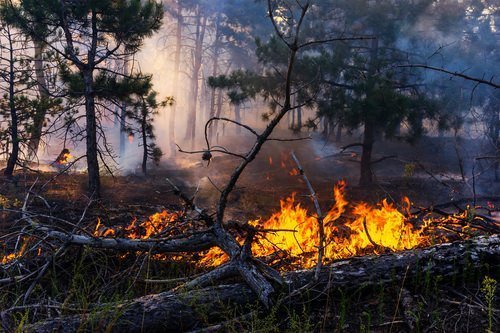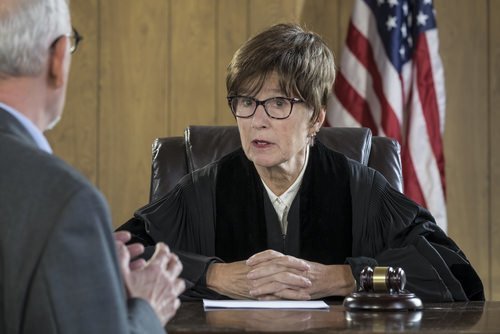According to CRS § 18-4-105, a person commits 4th-degree arson in Colorado if he or she “knowingly or recklessly starts or maintains a fire or causes an explosion, on his own property or that of another, and by so doing places another in danger of death or serious bodily injury or places any building or occupied structure of another in danger of damage.”
The offense is a Class 4 felony if you endanger a person. Otherwise, the penalties depend on the value of the property endangered.
There are 4 degrees of arson total (from most serious to least serious):
|
Colorado arson crime |
Penalties (generally) |
| First degree (CRS 18-4-102): knowingly damaging someone else’s building or occupied structure with fire or explosives. | Of an occupied structure: Class 3 felony: 4 to 12 years in prison and/or $3,000 to $750,000
Of a building: Class 4 felony: 2 to 6 years in prison and/or $2,000 to $500,000 |
| Second degree (CRS 18-4-103): burning a building or occupied structure without the owner’s consent. | A felony, misdemeanor, or petty offense depending on the value of the endangered property |
| Third degree (CRS 18-4-104): setting fire in order to defraud someone. | Class 5 felony: 1 to 3 years in prison and/or $2,000 to $500,000 |
| Fourth degree (CRS 18-4-105): endangering someone else or their property by setting a fire. |
If someone is endangered Class 4 felony: 2 to 6 years in prison and/or $2,000 to $500,000 If no one is endangered A felony, misdemeanor, or petty offense depending on the value of the endangered property |
You could also have to pay the victim restitution for the property damage.
In this article, our Denver Colorado criminal defense attorneys will explain:
- 1. What is fourth-degree arson under CRS 18-4-105?
- 2. What are the best defenses to a charge of fourth-degree arson?
- 3. What are the penalties for a conviction under CRS 18-4-105?
- 4. Related offenses to arson in the fourth degree
- Additional resources

Fourth-degree arson is treated as a Class 4 Felony in Colorado.
1. What is fourth-degree arson under CRS 18-4-105?
The crime of fourth-degree arson in Colorado is defined in CRS 18-4-105. This statute makes it illegal to put someone else or their property in danger of a fire you started or maintained.
The defining factors that make fourth-degree arson different from other degrees are:
- There do not have to be any injuries or property damage, and
- The fire or explosion can threaten property or people.
What does it mean to “endanger” someone or their property?
You can be liable for fourth-degree arson under CRS 18-4-105 if you endanger someone else or their property.
To endanger someone or their property means to put them at risk of
- death or
- serious bodily injury as a result of the fire.
That risk of danger of death or danger of damage does not have to be imminent.1
It also does not have to be severe – the threatened damage can be minor.2 Whether a fire or explosion endangered someone or their property is a question the jury will have to decide.
This crime element makes fourth-degree arson different from other degrees of arson. Other arson offenses require there to be property damage. Fourth-degree arson does not.
Do I have to intend to commit arson in the fourth degree?
You do not have to intend to start or maintain the fire, or put someone else at risk.
You only have to start the fire recklessly to violate CRS 18-4-105. You do not, however, have to foresee its consequences.3 You can violate CRS 18-4-105 even if you were unaware of the danger you caused.4
Firefighters are endangered when they respond to a fire
If the fire endangers anyone, it can lead to arson charges in the fourth degree. This includes firefighters.5 If firefighters respond to the blaze, it can trigger a fourth-degree arson charge.
What kind of property has to be endangered?
A violation of CRS 18-4-105 requires there to be a danger to a
- building or
- occupied structure.
A building is something that was designed to house people, animals, or property.6 It does not have to be occupied when threatened by the fire.
Examples of buildings include a:
- Dwelling,
- Garage,
- Truck trailer,7 and
- Mobile home.8
An occupied structure is an area or enclosure used by people or animals.9 It does not have to be occupied at the time of the fire. Examples include a:
- Campground,
- Car, and
- Outdoor dog kennels.10

A defense attorney can sometimes get charges reduced or dismissed.
2. What are the best defenses to a charge of fourth-degree arson?
There are 3 common legal defenses to a charge of fourth-degree arson in Colorado:
- The fire or explosion did not put anyone in danger,
- The fire was an accident, and
- The fire was the result of a controlled agricultural burn.
(Other potential defenses include law enforcement misconduct, such as if the police officer coerced a confession.)
No one was put in danger
If neither property nor people were put in danger, you cannot be liable for fourth-degree arson. Additionally, if only property was imperiled, the penalties of a conviction are lower.
The fire was accidental
Fourth-degree arson requires the fire or explosion to be at least recklessly set. You cannot be held liable for fourth-degree arson if the fire was an accident.
You were performing a controlled agricultural burn
CRS 18-4-105 explicitly says reasonably cautious and controlled agricultural burns that do not hurt anyone are not fourth-degree arson.
A controlled agricultural burn is a farming technique. It clears the land of crop residue and weeds by setting them on fire.
3. What are the penalties for a conviction under CRS 18-4-105?
Fourth-degree arson is a class 4 felony if a person is endangered. The sentence is:
- 2 – 6 years in prison, and/or
- $2,000 – $500,000.
If no one is endangered, the punishment for fourth-degree arson turns on the value of the property endangered.
|
Value of Property |
Colorado 4th-Degree Arson Penalties |
| Less than $300 | Petty offense:
|
| $300 to less than $1,000 | Class 2 misdemeanor:
|
| $1,000 to less than $2,000 | Class 1 misdemeanor:
|
| $2,000 to less than $5,000 | Class 6 felony:
|
| $5,000 to less than $20,000 | Class 5 felony:
|
| $20,000 to less than $100,000 | Class 4 felony:
|
| $100,000 to less than $1,000,000 | Class 3 felony:
|
| $1,000,000 or more | Class 2 felony:
|
Judges can also force defendants to pay restitution to the victim.11
4. Related offenses to arson in the fourth degree
Some criminal offenses are related to fourth-degree arson. They are:
- First-degree arson (CRS 18-4-102), which requires damage to a building or occupied structure,
- Second-degree arson (CRS 18-4-103), which requires damage to any kind of property,
- Third-degree arson (CRS 18-4-104), which requires property damage with an intent to defraud, and
- Criminal mischief (CRS 18-4-501), which involves damaging someone else’s property without the use of fire.
Additional resources
For more in-depth information on arson laws, refer to these scholarly articles:
- The Evolution of Fire Investigation and its Impact on Arson Cases – Criminal Justice.
- The Metamorphosis of the Law of Arson – Missouri Law Review.
- Assessment, Treatment and Sentencing of Arson Offenders: An Overview – Psychiatry, Psychology, and Law.
- Legal Aspects of Arson – Journal of Criminal Law, Criminology & Police Science.
- The Crime of Arson – Journal of Criminal Law & Criminology.
Legal References:
- § 18-4-105 CRS. The full language of the code section reads as follows:
(1) A person who knowingly or recklessly starts or maintains a fire or causes an explosion, on his own property or that of another, and by so doing places another in danger of death or serious bodily injury or places any building or occupied structure of another in danger of damage commits fourth degree arson.
(2) Fourth degree arson is a class 4 felony if a person is thus endangered.
(3) Fourth degree arson is:
(a) A petty offense if only property is thus endangered and the value of the property is less than three hundred dollars;
(b) A class 2 misdemeanor if only property is thus endangered and the value of the property is three hundred dollars or more but less than one thousand dollars;
(c) A class 1 misdemeanor if only property is thus endangered and the value of the property is one thousand dollars or more but less than two thousand dollars;
(d) A class 6 felony if only property is thus endangered and the value of the property is two thousand dollars or more but less than five thousand dollars;
(e) A class 5 felony if only property is thus endangered and the value of the property is five thousand dollars or more but less than twenty thousand dollars;
(f) A class 4 felony if only property is thus endangered and the value of the property is twenty thousand dollars or more but less than one hundred thousand dollars;
(g) A class 3 felony if only property is thus endangered and the value of the property is one hundred thousand dollars or more but less than one million dollars; and
(h) A class 2 felony if only property is thus endangered and the value of the property is one million dollars or more.
(4) Repealed.(5) It shall not be an arson offense pursuant to this section if:
(a) A person starts and maintains a fire as a controlled agricultural burn in a reasonably cautious manner; and
(b) No person suffers any of the following as a result of the fire:
(I) Bodily injury;
(II) Serious bodily injury; or
(III) Death.
(6) For purposes of this section, “controlled agricultural burn” means a technique used in farming to clear the land of any existing crop residue, kill weeds and weed seeds, or reduce fuel buildup and decrease the likelihood of a future fire.
See also People v. Garcia, 541 P.2d 687 (1975).
- People v. Garcia, Supra.
- People v. Garcia, Supra.
- Copeland v. People, 2 P.3d 1283 (Colo. 2000).
- Copeland v. People, Supra
- C.R.S. § 18-4-101(1).
- People v. Simien, 671 P.2d 1021 (Colo. App. 1983).
- People ex rel. VanMeveren v. District Court, 619 P.2d 494 (Colo. 1980).
- Colorado Revised Statute § 18-4-101(1).
- People v. Moyer, 635 P.2d 553 (Colo. 1981).
- CRS 18-4-105. Before March 1, 2022, if property worth $100 or more was endangered (and no person was endangered), 4th degree arson was a class 2 misdemeanor carrying 3 to 12 months in jail and/or $250 to $1,000 in fines. If the property was worth $99 or less (and no person was endangered), then 4th degree arson was a class 3 misdemeanor carrying up to 6 months in jail and/or $50 to $750 in fines. SB21-271.
